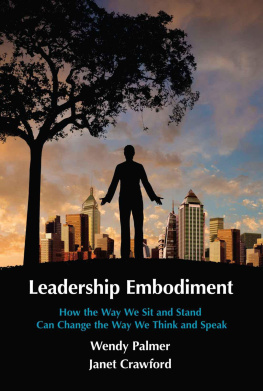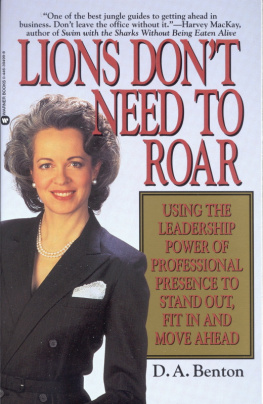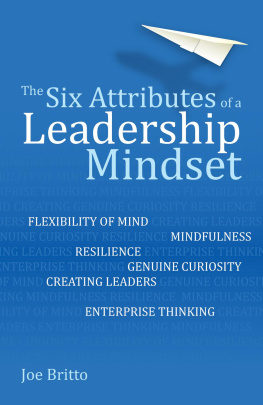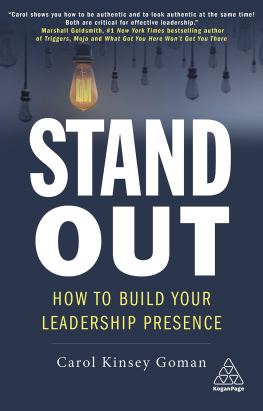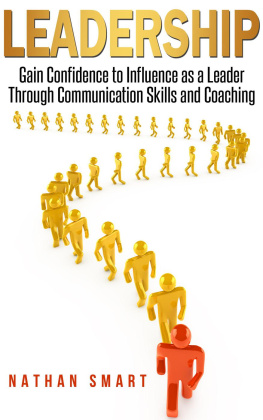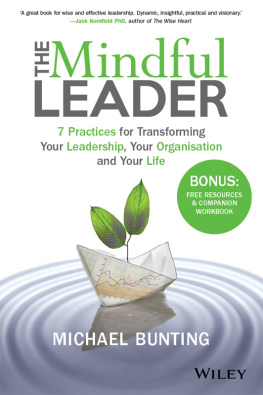LEADERSHIP
EMBODIMENT
Also by Wendy Palmer
The Intuitive Body,
Discovering the Wisdom of Conscious Embodiment and Aikido
and
The Practice of Freedom,
Aikido Principles as a Spiritual Guide
Leadership
Embodiment
How the Way We Sit and Stand
Can Change the Way We Think and Speak
Wendy Palmer
Janet Crawford
All rights reserved. No portion of this book, except for brief review, may be reproduced, stored in a retrieval system, or transmitted in any form or by any means-electronic, mechanical, photocopying, recording, or otherwise-without written permission of the publisher.
For information contact Emodiment International
http://embodimentinternational.com
Leadership Embodiment 2013 by Wendy Palmer and Janet Crawford
PLEASE NOTE: The creators and publishers of this book are not and will not be responsible, in any way whatsoever, for any improper use made by anyone of the information contained in this book. All use of the aforementioned information must be made in accordance with what is permitted by law, and any damage liable to be caused as a result thereof will be the exclusive responsibility of the user. In addition, he or she must adhere strictly to the safety rules contained in the book, both in training and in actual implementation of the information presented herein. This book is intended for use in conjunction with ongoing lessons and personal training with an authorized expert. It is not a substitute for formal training. It is the sole responsibility of every person planning to train in the techniques described in this book to consult a licensed physician in order to obtain complete medical information on his or her personal ability and limitations. The instructions and advice printed in this book are not in any way intended as a substitute for medical, mental, or emotional counseling with a licensed physician or healthcare provider.
The Practice 2013 Wendy Palmer
The Biology Behind It All 2013 Janet Crawford
Cover Art: John Lund http://www.johnlund.com
Photo of Wendy Palmer 2012 John Lund
Photo of Janet Crawford 2012 John Popplewell
Conceptual and Managing Editor: Joan Marie Passalacqua
Part One illustrations: 1a through 6a 2013 J.F. Mahoney
http://www.candraw.net
Part Two illustrations: 8a, 9b, 10a Janet Crawford; 8b, 9a iStockphoto
Image editing by Richard Leeds
Book Design: Colleen Dwire http://www.colleendwire.com
First Edition / Fall 2013
Printed by CreateSpace, An Amazon.com Company
ISBN-10: 1492946699
ISBN-13: 978-1492946694
Library of Congress Cataloging Number: 2013949941
The Embodiment Foundation
813 Vendola Drive,
San Rafael, California 94903
email: office@embodimentinternational.com
To our clients and students,
whose inquiry, dedication, and growth
inspire us to continue our development.
W.P. and J.C.
FOREWORD
by Michael J. Gelb
author of How to Think Like Leonardo da Vinci
T his book is entitled Leadership Embodiment .
What is leadership? And what is embodiment?
Peter Drucker, the legendary management consultant, penned my favorite definition of leadership. He wrote, Leadership is lifting a persons vision to high sights, the raising of a persons performance to a higher standard, the building of a personality beyond its normal limitations. The Free Online Dictionary defines embodiment as something or someone that embodies a spirit or principle.
I first met Wendy Palmer 25 years ago on the aikido mat and have had the pleasure of attending her classes and teaching at her school over the years. I can confirm that she embodies the spirit and principles of leadership as defined by Drucker. In this very practical book, Wendy translates this spirit and these principles into a manual for elevating your vision, raising your performance, and expanding your character beyond normal limitations. This book effectively communicates the lessons Wendy shares in her aikido classes and her international workshops with you.
For example, Wendy writes, Great leaders with a strong leadership presence can create the feeling of inclusion wherever they ar e a meeting room, a big auditorium, a playing field, and even on a conference call. Everyone included in their expanded personal space has a felt-sense that they are part of something bigger than themselves. Now thats a powerful concept! This book is filled with similarly important notions, but what makes it especially useful is that each powerful idea that is presented is accompanied by a practical exercise for the reader to embody the insight. The exercises are accompanied by Jen Mahoneys vivid illustrations making it as easy as possible for you to learn and practice.
When I first bowed on to the mat at Wendys dojo many years ago and saw a petite woman in the role of sensei, I was curious. Would she be able to effectively demonstrate Aikido techniques in response to real attacks from men who outweighed her by an average of about seventy-five pounds? As it turns out, yes, she could. But, what I liked most about Wendys classes was her presence. She filled the dojo with it in a way that included everyone and gave us all a sense that we were part of something bigger than ourselves. She did this with an energy and demeanor that was intense, but poised; fierce, but not angry. Best of all, when Wendy had trouble unbalancing or throwing an attacker, she responded with grace and without egotism. Instead of trying to force or fake her technique, she demonstrated genuine curiosity, and in front of the class, she would attempt to work out how she could improve. She usually succeeded, but more important than the lesson in technique was the example of how to learn and how to teach without arrogance or narcissism. When Wendy writes, the centered leader is brave and can welcome both success and failure with complete openness, it is not a theoretical construct, but again something she embodies.
One neednt be an Aikido practitioner to benefit from the lessons in this book. Aikido is a metaphor for resolving conflict in a creative and compassionate manner. This metaphor applies to our conflicts with others at home and at work, but most importantly, its relevant to resolving our own inner conflicts. The ability to resolve internal conflicts in order to become more fully oneself is a critical key to developing as a leader. The exercises that Wendy has originated to help you accomplish this dont require any martial arts background or special equipment. They all begin with a simple but elusive need for us to center ourselves in the face of stressful circumstances. Centering manifests in a state of mindfulness that makes it possible for us to respond to challenging situations with creativity, consciousness, and compassion. When we are un-centered, we respond automatically from the less evolved parts of our brains.
The practical instruction provided in these pages is complemented with an exploration of the science that helps us understand how our physiology and psychology are related.
In the fascinating Part Two entitled The Biology Behind It All , Wendys colleague, Janet Crawford, helps you understand how and why these practices work. Janet is a pioneer in the application of neuroscience to leadership, and after you read her incisive material your rational brain will be sold on the efficacy of the practices that you will learn from Wendy.
Beyond just validating the approach in Part One, The Practice , Janet aims to give you a new lens through which to observe the human operating system . She succeeds, and as you look through this new lens, youll discover fresh strategies for managing the complexity of contemporary life, transforming stress into enthusiasm, and understanding yourself and others with greater accuracy and compassion.

